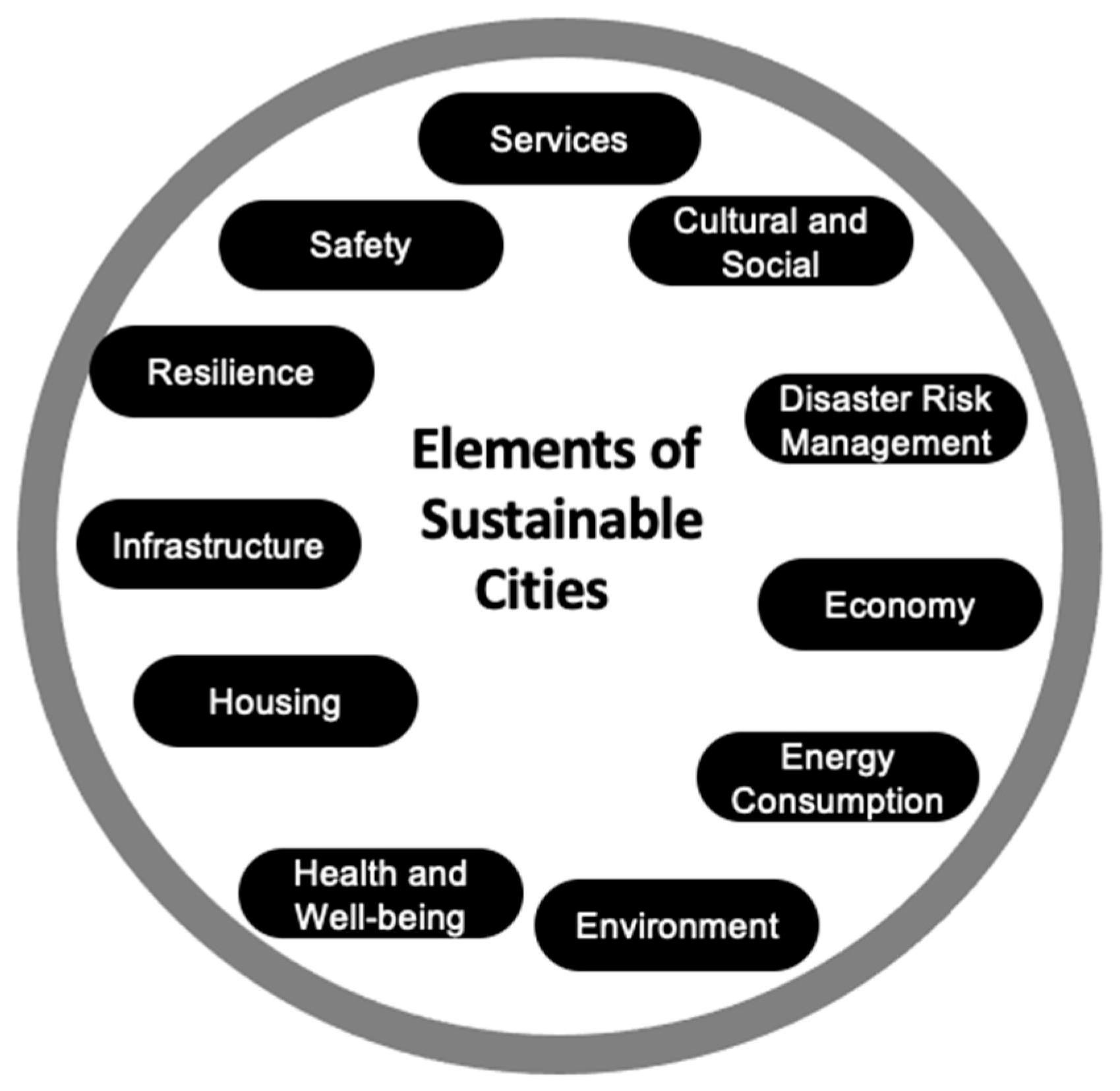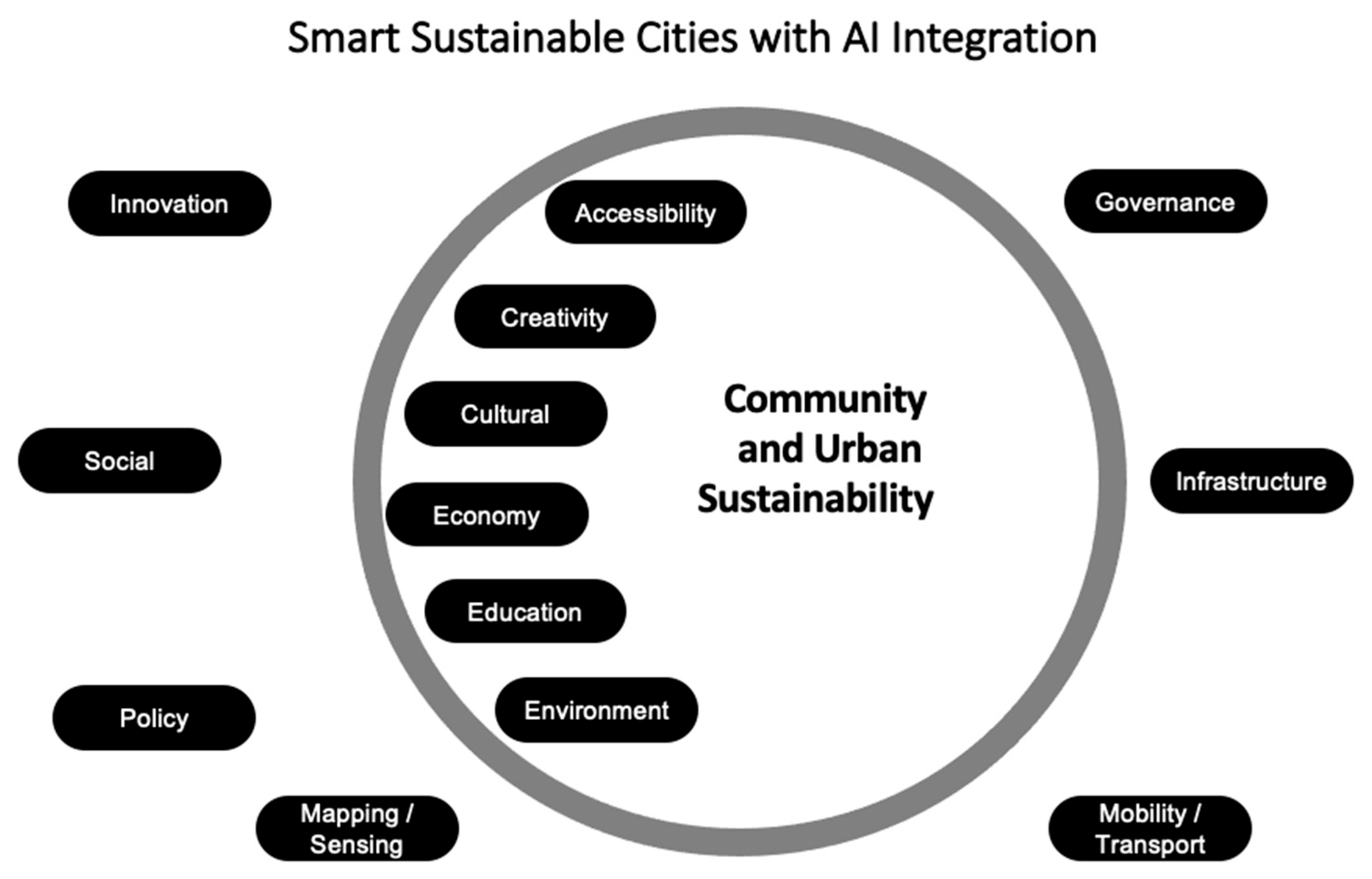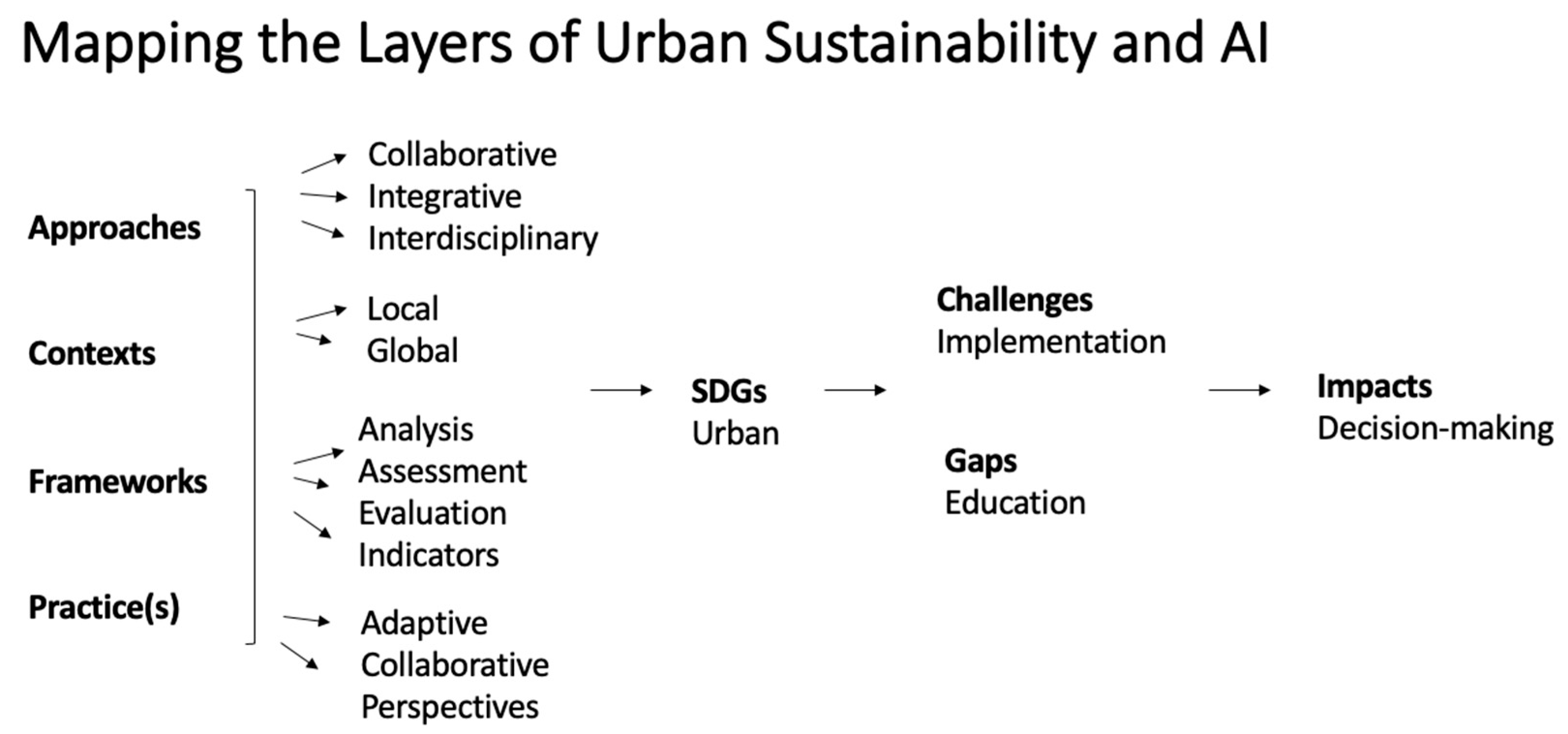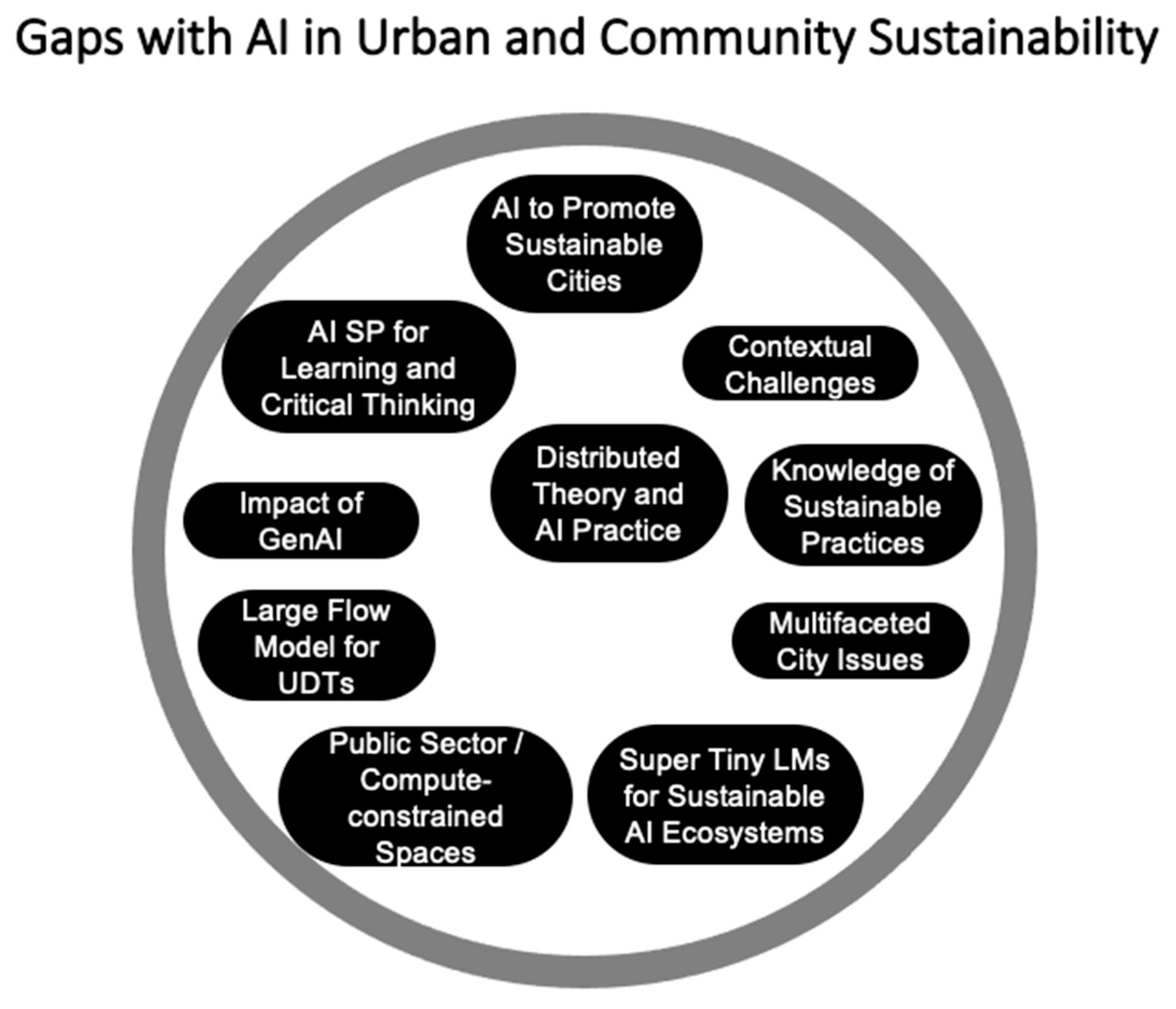Toward a ReThinking and ReImagining of Urban Sustainability in an Era of AI
Abstract
1. Introduction
1.1. Definitions
1.2. Objectives
1.3. Paper Overview
2. Methodology
3. Literature Review
3.1. Urban and Community Sustainability
3.2. AI and Urban and Community Sustainability
3.3. Conceptual Mapping of Urban and Community Sustainability and AI
4. Overview of the Focus and Challenges for Urban and Community Sustainability in an Era of AI
5. Discussion
5.1. Gaps in the Literature for Urban and Community Sustainability in an Era of AI
5.2. Reimaging and Rethinking Urban and Community Sustainability in an Era of AI
5.3. Probing Sustainability in an Era of AI
5.4. Recommendations for Urban Sustainability Considerations in an Era of AI
6. Limitations and Future Directions
7. Conclusions
Funding
Institutional Review Board Statement
Informed Consent Statement
Data Availability Statement
Conflicts of Interest
Abbreviations
| ACL | -able city lab |
| AENEA | Unified Stakeholders Needs Co-Creation Process |
| AI | Artificial Intelligence |
| AI-EO | Artificial Intelligence—Earth Observation |
| AIGC | Artificial Intelligence-Generated Content |
| AI SP | Artificial Intelligence Sparring Partner |
| AVs | Autonomous Vehicles |
| EO | Earth Observation |
| G7 | Group of Seven |
| Gen-AI | Generative Artificial Intelligence |
| HCAI | Human-Centered Artificial Intelligences |
| IJUSD | International Journal of Urban Sustainable Development |
| LFM | Large Flow Model |
| LUCGAN | Land Use Configuration Generative Adversarial Network |
| Mila | Quebec Artificial Intelligence Institute |
| MONET | Monitoring Sustainable Development |
| NANDA | Networked Agents And Decentralized Architecture |
| RAG | Retrieval Augmented Generation |
| SDGs | Sustainable Development Goals |
| SLMs | Small Language Models |
| STLMs | Super Tiny Language Models |
| STEEP | Social, Technological, Economical, Environmental, and Political |
| UN | United Nations |
| UNDP | United Nations Development Program |
| UDT | Urban Digital Twin |
| UGI | Urban Generative Intelligence |
| USIFs | Urban Sustainability Indicator Frameworks |
References
- Yigitcanlar, T.; Cugurullo, F. The Sustainability of Artificial Intelligence: An Urbanistic Viewpoint from the Lens of Smart and Sustainable Cities. Sustainability 2020, 12, 8548. [Google Scholar] [CrossRef]
- Zhang, D.; Pee, L.G.; Pan, S.L.; Liu, W. Orchestrating artificial intelligence for urban sustainability. Gov. Inf. Q. 2022, 39, 101720. [Google Scholar] [CrossRef]
- Leal Filho, W.; Mbah, M.F.; Dinis, M.A.P.; Trevisan, L.V.; de Lange, D.; Mishra, A.; Rebelatto, B.; Ben Hassen, T.; Aina, Y.A. The role of artificial intelligence in the implementation of the UN Sustainable Development Goal 11: Fostering sustainable cities and communities. Cities 2024, 150, 105021. [Google Scholar] [CrossRef]
- Lakusić, S.; Pavičić, J.; Stojčić, N.; Scholten, P.W.A.; van Sinderen Law, J. (Eds.) The Reimagining of Urban Spaces: A Journey Through Post-Industrial Cityscapes; Springer Nature: Cham, Switzerland, 2024. [Google Scholar] [CrossRef]
- Weng, Q.; Li, Z.; Cao, Y.; Lu, X.; Gamba, P.; Zhu, X.; Xu, Y.; Zhang, F.; Qin, R.; Yang, M.Y.; et al. How will ai transform urban observing, sensing, imaging, and mapping? npj Urban Sustain. 2024, 4, 50. [Google Scholar] [CrossRef]
- Owojori, O.M.; Erasmus, L.J. Urban sustainability reporting through the metaverse: Advancing transparency and accountability in the built environment. EDPACS 2025, 70, 34–62. [Google Scholar] [CrossRef]
- IJUSD. Article Collection on AI for Smarter and Sustainable Cities: Innovations, Challenges and Future Directions. Int. J. Urban Sustain. Dev. 2025. Available online: https://think.taylorandfrancis.com/article_collections/ai-for-smarter-and-sustainable-cities-innovations-challenges-and-future-directions/ (accessed on 15 May 2025).
- Tiwari, A. Beyond automation: The emergence of agentic urban AI. Automation 2025, 6, 29. [Google Scholar] [CrossRef]
- Cugurullo, F.; Caprotti, F.; Cook, M.; Karvonen, A.; McGuirk, P.; Marvin, S. Artificial Intelligence and the City: Urbanistic Perspectives on AI; Routledge: London, UK, 2023. [Google Scholar] [CrossRef]
- Clark, J.; Barton, B.; Albarqouni, L.; Byambasuren, O.; Jowsey, T.; Keogh, J.; Liang, T.; Moro, C.; O’Neill, H.; Jones, M. Generative artificial intelligence use in evidence synthesis: A systematic review. Res. Synth. Methods 2025, 16, 601–619. [Google Scholar] [CrossRef]
- Nam, T.; Pardo, T.A. Conceptualizing smart city with dimensions of technology, people, and institutions. In Proceedings of the 12th Annual International Digital Government Research Conference: Digital Government Innovation in Challenging Times, College Park, MD, USA, 12–15 June 2011; pp. 282–291. [Google Scholar]
- Moura, F.; de Abreu e Silva, J. Smart Cities: Definitions, Evolution of the Concept, and Examples of Initiatives. In Industry, Innovation and Infrastructure; Leal Filho, W., Azul, A.M., Brandli, L., Lange Salvia, A., Wall, T., Eds.; Encyclopedia of the UN Sustainable Development Goals; Springer: Cham, Switzerland, 2021. [Google Scholar] [CrossRef]
- Yigitcanlar, T.; Hoon, M.; Kamruzzaman, M.; Ioppolo, G.; Sabatini-Marques, J. The making of smart cities: Are Songdo, Masdar, Amsterdam, San Francisco and Brisbane the best we could build? Land Use Policy 2019, 88, 104187. [Google Scholar] [CrossRef]
- United Nations. Sustainability. Academic Impact. 2025. Available online: https://www.un.org/en/academic-impact/sustainability (accessed on 31 May 2025).
- Chiu, E.; Kikuzawa, Y. The Future of Urban Sustainability: Implications for Governance. 2023. Available online: https://knowledge.csc.gov.sg/ethos-issue-24/the-future-of-urban-sustainability-implications-for-governance/ (accessed on 2 June 2025).
- McKenna, H.P. Improving our awareness of data generation, use, and ownership: People and data interactions in AI-rich environments. In Distributed, Ambient and Pervasive Interactions. HCII 2025; Streitz, N.A., Konomi, S., Eds.; Lecture Notes in Computer Science; Springer: Cham, Switzerland, 2025; Volume 15802. [Google Scholar] [CrossRef]
- Merino-Saum, A.; Halla, A.; Superti, V.; Boesch, A.; Binder, C.R. Indicators for urban sustainability: Key lessons from a systematic analysis of 67 measurement initiatives. Ecol. Indic. 2020, 119, 106879. [Google Scholar] [CrossRef]
- Crane, M.; Simon, S.; Haines, A.; Ding, D.; Hutchinson, E.; Belesova, K.; Davies, M.; Osrin, D.; Zimmermann, N.; Capon, A.; et al. Transforming cities for sustainability: A health perspective. Environ. Int. 2021, 147, 106366. [Google Scholar] [CrossRef]
- Halla, P.; Wyss, R.; Athanassiadis, A.; Drevon, G.; Hensel, M.U.; Kaufmann, V.; Koseki, S.A.; Turcu, C.; Vilsmeier, U.; Binder, C.R. Using Metaphors for Addressing Urban Sustainability. Available online: https://ideas.repec.org/p/osf/socarx/kdzxt.html (accessed on 15 May 2025).
- Hölscher, K.; Frantzeskaki, N. Perspectives on urban transformation research: Transformations in, of, and by cities. Urban Transform. 2021, 3, 2. [Google Scholar] [CrossRef]
- Michalina, D.; Mederly, P.; Diefenbacher, H.; Held, B. Sustainable urban development: A review of urban sustainability indicator frameworks. Sustainability 2021, 13, 9348. [Google Scholar] [CrossRef]
- Wheeler, S.M.; Rosan, C.D. Reimagining Sustainable Cities: Strategies for Designing Greener, Healthier, More Equitable Communities; University of California Press: Oakland, CA, USA, 2021; Available online: https://www.ucpress.edu/books/reimagining-sustainable-cities/epub-pdf (accessed on 30 July 2025).
- Bansard, J. Pathways to Sustainable Development. Policy Brief #37, International Institute for Sustainable Development (IIDS), Earth Negotiations Bulletin. 2022. Available online: https://www.iisd.org/system/files/2022-04/still-one-earth-sustainable-cities.pdf (accessed on 29 July 2025).
- Gutierrez-Velez, V.H.; Gilbert, M.R.; Kinsey, D.; Behm, J.E. Beyond the ‘urban’ and the ‘rural’: Conceptualizing a new generation of infrastructure systems to enable rural–urban sustainability. Curr. Opin. Environ. Sustain. 2022, 56, 101177. [Google Scholar] [CrossRef]
- Zhang, J.; Quoquab, F.; Mohammad, J. Plastic and sustainability: A bibliometric analysis using VOSviewer and CiteSpace. Arab Gulf J. Sci. Res. 2024, 42, 44–67. [Google Scholar] [CrossRef]
- Yasuoka Jensen, M.; Malmgren, J. A Role of Smart Villages–Five Reasons to Start with Smart Villages as Living Lab for Future Smart Cities. In Distributed, Ambient and Pervasive Interactions; HCII 2025; Streitz, N.A., Konomi, S., Eds.; Lecture Notes in Computer Science; Springer: Cham, Switzerland, 2025; Volume 15803. [Google Scholar] [CrossRef]
- Monoi, A.; Kamio, R.; Doi, M.; Tamura, H.; Kibi, Y.; Yasuoka Jensen, M. The Design Pattern of Participatory Urban Design for the “-Able City” -Applying Copenhagen’s Pattern to Japanese Case. In Distributed, Ambient and Pervasive Interactions. HCII 2025; Streitz, N.A., Konomi, S., Eds.; Lecture Notes in Computer Science; Springer: Cham, Switzerland, 2025; Volume 15803. [Google Scholar] [CrossRef]
- United Nations. Goal 11: Make Cities Inclusive, Safe, Resilient and Sustainable. United Nations Sustainable Development Goals. 2025. Available online: https://www.un.org/sustainabledevelopment/cities/ (accessed on 22 July 2025).
- Batty, M. The Computable City: Histories, Technologies, Stories, Predictions; The MIT Press: Cambridge, MA, USA, 2024. [Google Scholar] [CrossRef]
- Camaréna, S. Engaging with artificial intelligence (AI) with a bottom-up approach for the purpose of sustainability: Victorian Farmers Market Association, Melbourne Australia. Sustainability 2021, 13, 9314. [Google Scholar] [CrossRef]
- Hendawy, M.; da Silva, I.F.K. Hybrid smartness: Seeking a balance between top-down and bottom-up smart city approaches. In Intelligence for Future Cities; Goodspeed, R., Sengupta, R., Kyttä, M., Pettit, C., Eds.; CUPUM 2023; The Urban Book Series; Springer: Cham, Switzerland, 2023. [Google Scholar]
- Jha, A.K.; Ghimire, A.; Thapa, S.; Jha, A.M.; Raj, R. A review of AI for urban planning: Towards building sustainable smart cities. In Proceedings of the 2021 6th International Conference on Inventive Computation Technologies (ICICT), Coimbatore, India, 20–22 January 2021; pp. 937–944. [Google Scholar] [CrossRef]
- Koseki, S.; Jameson, S.; Farnadi, G.; Rolnick, D.; Régis, C.; Denis, J.-L.; Leal, A.; de Bezenac, C.; Occhini, G.; Lefebvre, H.; et al. AI and Cities: Risks, Applications and Governance; Mila—Quebec Artificial Intelligence Institute; UN Habitat for a Better Future: Nairobi, Kenya, 2022; Available online: https://unhabitat.org/sites/default/files/2022/10/artificial_intelligence_and_cities_risks_applications_and_governance.pdf (accessed on 7 May 2024).
- Schintler, L.A.; McNeely, C.L. Artificial intelligence, institutions, and resilience: Prospects and provocations for cities. J. Urban Manag. 2022, 11, 256–268. [Google Scholar] [CrossRef]
- Koutalieris, G.; Symeonidis, S.; Kapsomenaki, I.; Feio, M.J.; Esposito, L.; Benis, A. Enhancing urban environmental sustainability through unified stakeholders needs co-creation process (AENEA). In Proceedings of the 2023 IEEE International Conference on Metrology for eXtended Reality, Artificial Intelligence and Neural Engineering (MetroXRAINE), Milano, Italy, 25–27 October 2023; pp. 899–904. [Google Scholar] [CrossRef]
- EU. Protecting Urban Aquatic Ecosystems to Promote One Health; European Commission: Brussels, Belgium, 2025. [Google Scholar] [CrossRef]
- Palmini, O.; Cugurullo, F. Charting AI urbanism: Conceptual sources and spatial implications of urban artificial intelligence. Discov. Artif. Intell. 2023, 3, 15. [Google Scholar] [CrossRef]
- Hazbei, M.; Cucuzzella, C. Revealing a gap in parametric architecture’s address of “context”. Buildings 2023, 13, 3136. [Google Scholar] [CrossRef]
- Xu, F.; Zhang, J.; Gao, C.; Feng, J.; Li, Y. Urban Generative Intelligence (UGI): A foundational platform for agents in embodied city environment. arXiv 2023, arXiv:2312.11813. [Google Scholar] [CrossRef]
- Shulajkovska, M.; Smerkol, M.; Noveski, G.; Gams, M. Enhancing urban sustainability: Developing an open-source AI framework for smart cities. Smart Cities 2024, 7, 2670–2701. [Google Scholar] [CrossRef]
- Tripathi, S.; Bachmann, N.; Brunner, M.; Rizk, Z.; Jodlbauer, H. Assessing the current landscape of AI and sustainability literature: Identifying key trends, addressing gaps and challenges. J. Big Data 2024, 11, 65. [Google Scholar] [CrossRef]
- Batty, M. Generative AI. Environ. Plan. B Urban Anal. City Sci. 2025, 52, 1031–1034. [Google Scholar] [CrossRef]
- McKenna, H.P. AI in Urban Life: Perspective, Challenges, and Opportunities; Springer Nature: Cham, Switzerland, 2025. [Google Scholar] [CrossRef]
- Lartey, D.; Law, K.M.Y. Artificial intelligence adoption in urban planning governance: A systematic review of advancements in decision-making, and policy making. Landsc. Urban Plan. 2025, 258, 105337. [Google Scholar] [CrossRef]
- Prime Minister of Canada. G7 Leaders’ Statement on AI for Prosperity. 2025. Available online: https://www.pm.gc.ca/en/news/statements/2025/06/17/g7-leaders-statement-ai-prosperity (accessed on 18 June 2025).
- United Nations Development Program (UNDP). AI Hub for Sustainable Development. 2025. Available online: https://www.aihubfordevelopment.org (accessed on 19 June 2025).
- Cezario, B.S.; Moreira, O.J.; Peres, O.B.; Bilotta, P.; Soares, C.A.P.; Guedes, A.L.A. Smart cities, people at the center: A collaborative mapping with AI for a sustainable future. In Environmental, Social, Governance and Digital Transformation in Organizations; Machado, A.D.B., Sousa, M.J., Brambilla, A., Pesqueira, A., Rocha, A., Eds.; Information Systems Engineering and Management; Springer: Cham, Switzerland, 2025; Volume 35. [Google Scholar] [CrossRef]
- Herrmann, T. AI as a Sparring Partner—An HCAI Approach to Promote Human Capabilities. In Artificial Intelligence in HCI. HCII 2025; Degen, H., Ntoa, S., Eds.; Lecture Notes in Computer Science; Springer: Cham, Switzerland, 2025; Volume 15820. [Google Scholar] [CrossRef]
- Mittal, A. Rethinking Distributed Computing for the AI Era: We Need to Rethink How We Approach Distributed Computing for AI. Communications of the ACM Blog@CACM. 2025. Available online: https://cacm.acm.org/blogcacm/rethinking-distributed-computing-for-the-ai-era/ (accessed on 22 July 2025).
- Mutambara, P.D.E. Deploying Artificial Intelligence to Achieve the UN Sustainable Development Goals: Enablers, Drivers and Strategic Frameworks; Sustainable Development Goals Series; Springer: Cham, Switzerland, 2025. [Google Scholar] [CrossRef]
- Wang, H.; Liu, Y. The mechanism, patterns, and directional considerations of generative AI empowering urban cultural renewal. In Design, User Experience, and Usability. HCII 2025; Schrepp, M., Ed.; Lecture Notes in Computer Science; Springer: Cham, Switzerland, 2025; Volume 15799. [Google Scholar] [CrossRef]
- Yue, Y.; Yan, G.; Lan, T.; Cao, R.; Gao, Q.; Gao, W.; Huang, B.; Huang, G.; Huang, Z.; Kan, Z.; et al. Shaping future sustainable cities with AI-powered urban informatics: Toward human-AI symbiosis. Comput. Urban Sci. 2025, 5, 31. [Google Scholar] [CrossRef]
- Challapally, A.; Pease, C.; Raskar, R.; Chari, P. The GenAI Divide: State of AI in Business 2025. MIT NANDA. 2025. Available online: https://mlq.ai/media/quarterly_decks/v0.1_State_of_AI_in_Business_2025_Report.pdf (accessed on 31 August 2025).
- Holmes, I. City of Nanaimo Navigating AI Road Maintenance Tool During Three-Year Trial Period: Reimagined Road Maintenance. Nanaimo News Now. 2025. Available online: https://nanaimonewsnow.com/2025/08/18/city-of-nanaimo-navigating-ai-road-maintenance-tool-during-three-year-trial-period/ (accessed on 31 August 2025).
- Padi, D.; Thangavelu, C. A case study on the barriers to achieving a sustainable smart city. Int. J. Hum. Cap. Urban Manag. 2025, 10, 527–550. [Google Scholar] [CrossRef]
- Nanni, F.; Chan, R.; Lazauskas, T.; Geddes, J. Why We Still Need Small Language Models–Even in the Age of Frontier AI: Lean, Locally Run Models Can Unlock Huge Benefits for Public Sector and Compute-Constrained Environments. The Alan Turing Institute Blog. 2025. Available online: https://www.turing.ac.uk/blog/why-we-still-need-small-language-models-even-age-frontier-ai (accessed on 3 August 2025).
- Sandhu, J.A. Making Big Leaps with Small Models: What Are Small Language Models and Super Tiny Language Models? University of Toronto, Schwartz Reisman Institute for Technology and Society News. 2024. Available online: https://srinstitute.utoronto.ca/news/what-are-small-super-tiny-language-models (accessed on 3 August 2025).
- Huang, J.; Bibri, S.E.; Keel, P. Generative spatial artificial intelligence for sustainable smart cities: A pioneering large flow model for urban digital twin. Environ. Sci. Ecotechnology 2025, 24, 100526. [Google Scholar] [CrossRef]
- Kearns, P. Connecting people and planet for a sustainable future: The EcCoWell 3 approach to a sustainable future for learning cities. In Global Perspectives on Learning Cities; Ó Tuama, S., Agbessi, E., Neylon, T., Eds.; Lifelong Learning Book Series; Springer: Cham, Switzerland, 2025; Volume 35. [Google Scholar] [CrossRef]
- Mollick, E. On Working with Wizards: Verifying Magic on the Jagged Frontier. One Useful Thing Blog. 2025. Available online: https://www.oneusefulthing.org/p/on-working-with-wizards (accessed on 12 September 2025).
- Babbie, E.R. The Practice of Social Research; Wadsworth Publishing: Boston, MA, USA, 2020. [Google Scholar]
- Johnson, I.G.; Vlachokyriakos, V. Civic Probes: Amethod That Embeds Questions of Civic Infrastructure Participation Interactions, X.X.X.I.2. 2024. Available online: https://interactions.acm.org/archive/view/march-april-2024/civic-probes-a-method-that-embeds-questions-of-civic-infrastructure-and-participation (accessed on 16 September 2025).





| Areas of Focus | Frequency | Types of Challenges |
|---|---|---|
| Cultural | ✓✓✓✓✓ | Cultural content and urban renewal |
| Economic | ✓✓✓✓✓✓✓✓✓✓✓✓ | High costs of tech infrastructure |
| Environmental | ✓✓✓✓✓✓✓✓✓✓✓ | Water scarcity barriers |
| Ethical | ✓✓✓✓✓✓✓✓ | Alignment with urban planning |
| Governance | ✓✓✓✓✓✓✓✓ | Real-world actionable application of AI |
| Intelligence | ✓✓✓✓✓ | Agentic AI; human–AI |
| Privacy | ✓✓✓✓✓ | Data privacy and SLMs, STLMs |
| Regulatory | ✓✓✓✓ | Alignment; Outdated policies |
| Security | ✓✓✓ | AI model design and implementation |
| Social | ✓✓✓✓✓✓✓✓✓✓✓✓✓ | Social effects of technologies |
| Risks | ✓✓✓ | AI deployment |
| Technological | ✓ | Readiness |
| Trust | ✓✓ | AI systems |
| Author(s) | Year | Gaps |
|---|---|---|
| Hölscher & Frantzeskaki [20] | 2021 | Urban transformation perspectives |
| Leal Filho et al. [3] | 2024 | Knowledge gaps for sustainable practices AI contributing effectively to multifaceted city issues Using AI to promote sustainable cities |
| Sandhu [57] | 2024 | STLMs for more sustainable AI ecosystems |
| Cezario et al. [47] | 2025 | Understanding the impact of GenAI |
| Herrmann [48] | 2025 | AI SP for learning and critical thinking |
| Huang et al. [58] | 2025 | Large Flow Model for UDT systems |
| Mittal [49] | 2025 | Distributed systems theory and AI practice |
| Nanni et al. [56] | 2025 | Public sector; Compute-constrained spaces |
| Yue et al. [52] | 2025 | Contextual challenges and urban informatics |
| Author(s) | Year | Reimaging and Rethinking Urban Sustainability |
|---|---|---|
| Yigitcanlar & Cugurullo [1] | 2020 | Rethink economy and reimagine cities |
| Halla et al. [19] | 2021 | Metaphors for more sustainable cities |
| Wheeler & Rosan [22] | 2021 | Urban design and institutional restructuring |
| Bansard [23] | 2022 | Rethink livability with minimal environmental impact |
| Schintler & McNeely [34] | 2022 | Resilience thinking |
| Chiu and Kikuzawa [15] | 2023 | Futures lens: urban mining material recovery, reuse |
| Lakusić et al. [4] | 2024 | Reimagining post-industrial urban spaces |
| Kearns [59] | 2025 | EcCoWell 3 approach to sustainable futures |
| Monoi et al. [27] | 2025 | -able city as an alternative mindset and approach |
| Mittal [49] | 2025 | Rethinking approaches to distributed computing |
| Yue et al. [52] | 2025 | Envisioning mutual learning over automation |
| # | Options | (% n = 5) |
|---|---|---|
| 1 | Engage with students on this | 40% |
| 2 | City to city discussions | 60% |
| 3 | Human–AI teaming | 0% |
| 4 | I have no idea | 0% |
| 5 | Other (please specify) | 0% |
Disclaimer/Publisher’s Note: The statements, opinions and data contained in all publications are solely those of the individual author(s) and contributor(s) and not of MDPI and/or the editor(s). MDPI and/or the editor(s) disclaim responsibility for any injury to people or property resulting from any ideas, methods, instructions or products referred to in the content. |
© 2025 by the author. Licensee MDPI, Basel, Switzerland. This article is an open access article distributed under the terms and conditions of the Creative Commons Attribution (CC BY) license (https://creativecommons.org/licenses/by/4.0/).
Share and Cite
McKenna, H.P. Toward a ReThinking and ReImagining of Urban Sustainability in an Era of AI. Urban Sci. 2025, 9, 401. https://doi.org/10.3390/urbansci9100401
McKenna HP. Toward a ReThinking and ReImagining of Urban Sustainability in an Era of AI. Urban Science. 2025; 9(10):401. https://doi.org/10.3390/urbansci9100401
Chicago/Turabian StyleMcKenna, H. Patricia. 2025. "Toward a ReThinking and ReImagining of Urban Sustainability in an Era of AI" Urban Science 9, no. 10: 401. https://doi.org/10.3390/urbansci9100401
APA StyleMcKenna, H. P. (2025). Toward a ReThinking and ReImagining of Urban Sustainability in an Era of AI. Urban Science, 9(10), 401. https://doi.org/10.3390/urbansci9100401






